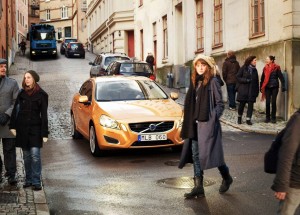The “fender-bender” is the bane of rush-hour travelers. But a new study says auto-braking safety systems, which are designed to react automatically should a driver miss an impending collision, are having, if you will, a major impact, preventing at least one in four rear-end collisions.
A study of insurance claims by the Highway Loss Data Institute found that Volvo’s City Safe system, in particular, reduced the number of vehicle damage claims by 27%, while insurance claims related to bodily injuries dropped by 51% on vehicles using the technology.
“This is our first real-world look at an advanced crash avoidance technology, and the findings are encouraging,” said Adrian Lund, president of the HLDI.
The City Safety system uses an infrared laser sensor attached to the windshield to monitor traffic in front of a vehicle. At speeds ranging from 2 to 19 mph – typical on crowded urban and in rush hour traffic – the system will detect a potential collision. If the driver doesn’t react by the time the two cars are 18 feet apart, it will automatically jam on the brakes.
The technology does have its limitations, fog and heavy rain or snow limiting the ability of the infrared sensors to peer out into traffic. And the greater the difference in speed between the Volvo and the car ahead the more difficult it becomes to prevent a crash.
While Volvo officials stress it cannot prevent all collisions, they believe City Safety will at least reduce the severity of a collision. The system was intentionally programmed to stop abruptly, however, so motorists do not come to rely on it to manage routine stops.
Nonetheless, said Lund, “City Safety is helping XC60 drivers avoid the kinds of front-to-rear, low-speed crashes that frequently happen on congested roads.”
Ironically, the Volvo XC60 actually had higher insurance claims than other vehicles in its segment, the HLDI study shows. “Although it may seem counterintuitive, higher payouts for property damage liability are a sign that City Safety works,” says Matthew Moore, the institute’s vice president and director of the study.
There was a sharp reduction in the number of low-cost claims normally associated with fender-benders. Higher-speed, higher-severity claims — those from collisions that City Safety wasn’t designed to prevent — were about on a par with other vehicles in the XC60’s class, HLDI found.
The City Safety technology became standard on the 2010 Volvo XC60 and has since been added on the S60 sedan. It will become standard equipment on the 2012 Volvo S80 and XC70 models, as well.
Volvo was the first maker to offer a technology specifically focused on preventing low-speed collisions, but variations of the technology are beginning to appear under other brands. Mercedes-Benz, for example, offers a safety system tied to its active, or radar-guided cruise control, that can not only maintain the pace of traffic but apply brakes if a motorist delays in the face of a pending collision.
Volvo, meanwhile, is updating its system to recognize pedestrians as well as motor vehicles. The optional feature – which now works at speeds up to 22 mph – is available on the S60.
City Safety has already received a number of honors, including the ‘Traffic Safety Achievement Award,’ presented during the World Traffic Safety Symposium, in New York, in 2009.

